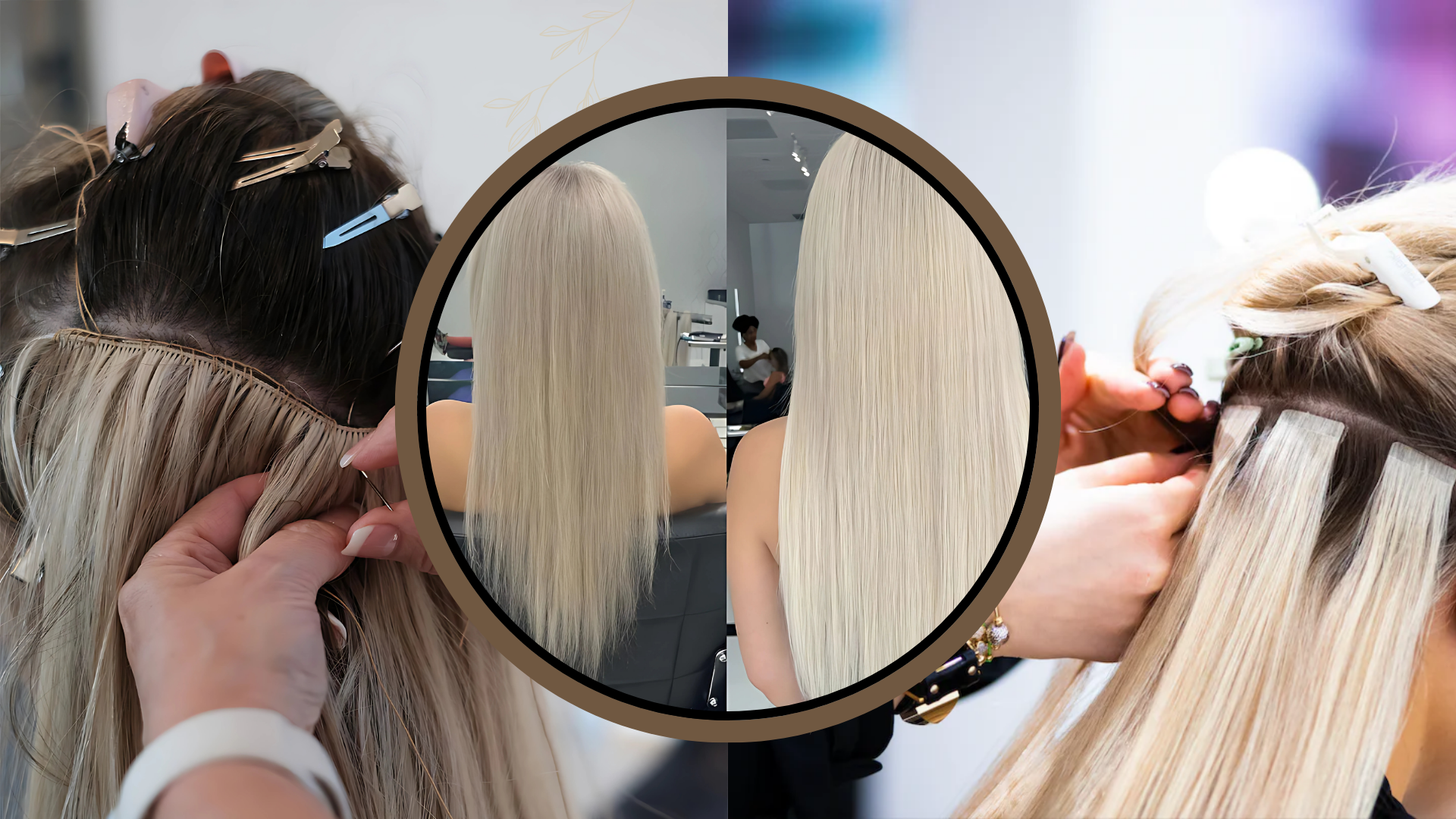Thinning hair. It’s one of those things no one really talks about… until it happens to you. Whether it’s stress, hormones, age, or genetics, noticing your hair becoming finer or patchier can be a real blow to your confidence. But here’s the good news: you’re not stuck with it. One of the quickest, most transformative solutions out there? Extensions for thinning hair.
Now, we know what you might be thinking – aren’t hair extensions just for adding length or creating big bouncy curls on a night out? Absolutely not. In fact, hair extensions have come a long way, and they can be a total game-changer for anyone struggling with fine or thinning hair. The key is finding the right type of extensions and applying them in a way that protects your natural hair while enhancing it – which is exactly what a professional Hair Extension Salon London can help you with.
Let’s dive into everything you need to know.
Why Use Extensions for Thinning Hair?
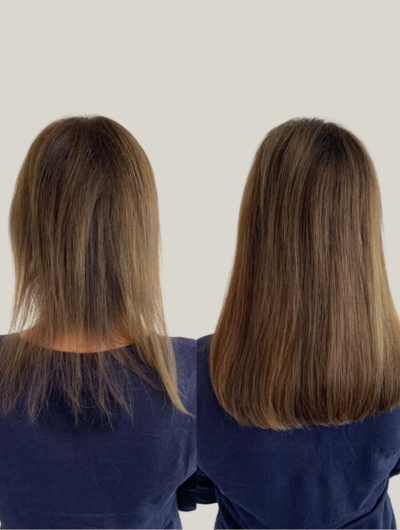
Before we get into the how, let’s talk about the why.
Thinning hair can make styling frustrating – your ponytail lacks volume, your scalp might peek through in photos, and some styles just don’t work anymore. Extensions can help by:
- Adding volume to areas where hair is sparse
- Concealing thinning patches around the crown or parting
- Boosting your confidence with fuller-looking hair
- Making styling easier with more “grip” and density
Unlike wigs or toppers, extensions offer a more natural, seamless look – when done correctly.

The Best Types of Extensions for Thinning Hair
Not all hair extensions are created equal – and not all are ideal for fine or thinning hair. If your hair is on the finer side, the last thing you want is a heavy method that stresses your roots or causes more shedding.
Here are the top options for extensions for thinning hair, along with their pros and cons:
1. Tape-In Extensions

Tape Hair extensions are thin, flat wefts of hair with a medical-grade adhesive strip at the top. During application, a section of your natural hair is “sandwiched” between two wefts and pressed together – no heat or tools required.
Best for: Adding volume and coverage across the crown and sides
How they work: Thin wefts of hair are “taped” between sections of your own hair using a gentle adhesive.
Pros:
- Lightweight and flat – they sit close to the scalp and blend beautifully
- Great for adding volume without bulk
- Quick to apply (usually under an hour)
Cons:
- Need maintenance every 6–8 weeks
- Can slip if your hair is very oily or soft
- You’ll need to avoid oily products near the roots
Verdict: A great semi-permanent option for people with finer hair who want natural-looking fullness.

2. Halo Extensions
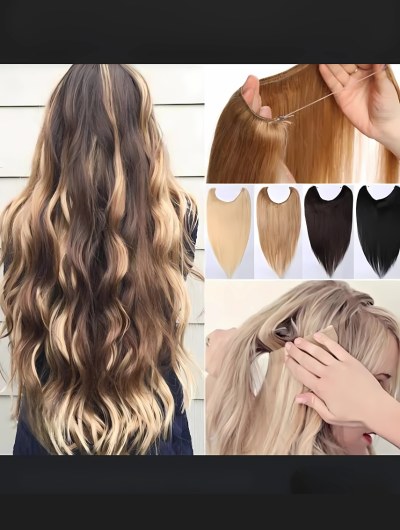
Halo extensions are a single weft of hair attached to a nearly invisible wire. You simply place it around the crown of your head like a halo (hence the name), then pull your natural hair over the top to hide the band. That’s it – no professional fitting required.
Best for: Occasional volume with zero commitment
How they work: A single weft of hair is attached to a nearly invisible wire that sits like a “halo” on your head.
Pros:
- Doesn’t attach to your natural hair at all – no damage
- Super easy to take on and off
- Great for events or short-term use
Cons:
- Can shift or move if not fitted properly
- Not ideal for everyday wear if you’re active or on the go
Verdict: Perfect for anyone with thinning hair who wants volume without maintenance.

3. Clip-In Extensions
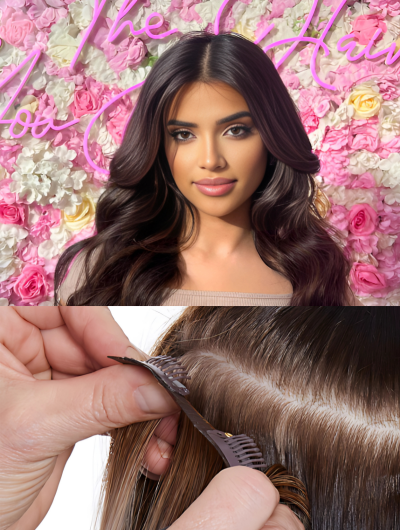
Clip-In Extensions Fitting & Blending is a great option for those who want an instant transformation without commitment. We help fit and blend clip-in extensions to ensure they look completely natural and match your hair perfectly. Whether you need them for a special occasion or everyday wear, we customise the fitting for a flawless result.
Best for: Beginners or occasional wear
How they work: Small clips are attached to wefts of hair that you clip into your natural hair.
Pros:
- Affordable and widely available
- You can apply them yourself at home
- Easy to remove
Cons:
- Can tug at delicate roots if worn daily
- Might feel heavy on very fine hair
- Not ideal for patchy hair or sensitive scalps
Verdict: Fine for special occasions, but use sparingly if your hair is particularly fragile.

4. Micro-Ring or Nano-Bead Extensions
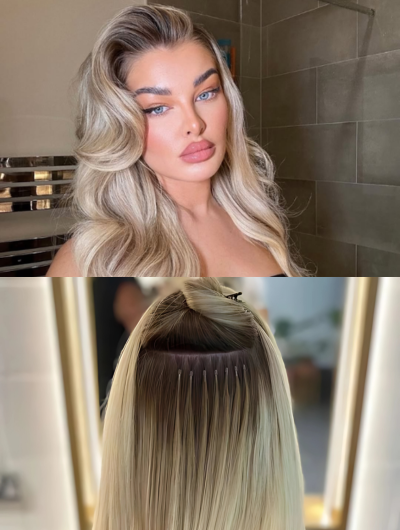
Nano & Micro Rings Extensions are a popular method for achieving a natural, long-lasting result without the use of heat or glue. Small, undetectable rings secure the extensions to your natural hair, ensuring a comfortable and secure fit. This method is perfect for those who want a more permanent extension solution that allows for easy maintenance and minimal damage.
Best for: Longer-term volume with a discreet finish
How they work: Small sections of extension hair are attached to your natural hair using tiny rings or beads.
Pros:
- No glue or heat required
- Can last for months with maintenance
- Blends well with natural hair
Cons:
- May tug or slip if your hair is very thin or fragile
- Needs a professional fitting
- Maintenance appointments are essential
Verdict: Can work for thinning hair if applied by a professional with experience in fine hair.

5. Keratin Bond Extensions
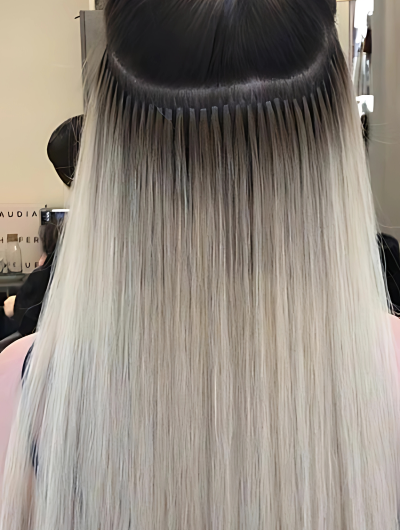
Keratin bonds (also known as fusion or pre-bonded extensions) involve tiny strands of extension hair, each tipped with a keratin-based adhesive. These are bonded to small sections of your natural hair using a gentle heat tool.
Best for: More permanent results (3–4 months)
How they work: Strands of extension hair are fused to your natural hair using keratin (the protein your hair is made of).
Pros:
- Long-lasting
- Bonds are discreet and easy to hide
- Customisable placement
Cons:
- Heat application can weaken hair if not done properly
- Removal requires a professional
- Not ideal if your hair is extremely fine or breaking
Verdict: If done carefully, keratin bonds can offer a natural look for those with mild to moderate thinning.

How to Choose the Right Method for You
Choosing the best extensions for thinning hair comes down to three main things: your lifestyle, your hair type, and your goals.
Here are a few questions to ask yourself:
- Is your hair thinning all over or in specific areas?
- Do you want something semi-permanent or removable?
- How much time (and budget) can you commit to upkeep?
- Are you comfortable with daily styling, or do you want a low-maintenance option?
If in doubt, book a consultation with a hair extension specialist who has experience working with fine hair. A good stylist will assess your scalp and strands, and recommend options that won’t cause further damage.
How to Make Extensions Look Natural on Fine Hair
The last thing you want is to invest in beautiful extensions and end up with a bulky or obvious finish. When dealing with fine or thinning hair, the technique is everything.
Here are a few tips to ensure a flawless result:
- Blend the colour – multi-tonal shades mimic real hair better than a flat, solid colour.
- Layer strategically – layering helps distribute weight and avoids “step” lines.
- Avoid heavy pieces – opt for lighter, finer wefts that won’t strain your roots.
- Place carefully – avoid attaching extensions too close to the hairline or parting.
Cut to match your style – a dry trim with extensions in place helps them blend seamlessly.
Caring for Extensions on Thinning Hair
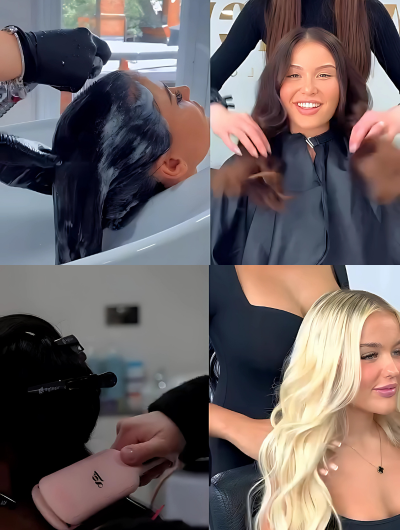
When you’ve got extensions and delicate hair, care is everything. Here’s how to make sure your extensions last – and your natural hair stays healthy underneath:
- Brush Gently: Use a soft-bristle brush or loop brush designed for extensions. Always start at the end and work up slowly.
- Avoid Heavy Oils at the Roots: Especially for tape-ins, oily roots can loosen the adhesive.
- Sleep with Care: Tie your hair in a loose plait or use a silk pillowcase to reduce friction overnight.
- Be Mindful of Heat: If you style your hair regularly, use a heat protectant – and avoid high temperatures near the bonds or tape.
- Book Regular Maintenance: Whether it’s repositioning tape-ins or tightening micro rings, regular salon visits will help your extensions last and prevent matting.

Potential Risks (and How to Avoid Them)
As amazing as extensions for thinning hair can be, they’re not totally risk-free. The most common issues?
- Breakage from heavy extensions pulling on delicate roots
- Traction alopecia if extensions are too tight or worn incorrectly
- Scalp irritation from adhesives or incorrect placement
To minimise risk, always:
- Choose a lightweight method suitable for fine hair
- Avoid DIY application for semi-permanent options
- Work with an experienced professional
- Give your scalp breaks between sets
Are Extensions Right for You?
If your thinning hair is making you feel less confident or limiting your styling options, extensions could absolutely be part of your solution. But it’s important to approach them as a supportive, not permanent fix. They’re amazing for creating fullness, styling flexibility, and that “I feel like myself again” feeling.
That said, extensions should never make your hair worse – so choose quality, go to a trusted salon, and work with a reputable hair extension supplier to ensure your strands stay safe and healthy. Always keep scalp health front of mind.
Extensions for thinning hair: To Sum It All Up
Hair thinning can be frustrating – but it doesn’t mean giving up on having the hair you love. Whether you’re after a bit of volume around the front or a full transformation, there’s an extension method out there to suit your needs.
The bottom line? Extensions for thinning hair can offer real, visible results without major commitment – as long as you pick the right type and look after them properly.
So, ready to get that volume back? Your hair goals are just a few strands away.
FAQ
Are extensions safe for thinning hair?
Yes – as long as you choose the right method and have them applied by a professional. The key is to use lightweight extensions that won’t pull on fragile roots. Tape-ins, halos, or carefully applied micro-rings are often good options for thinning hair. Always avoid heavy or tight applications that could cause stress on the scalp.
Which type of extensions is best for thinning hair?
It depends on your hair condition and lifestyle. Tape-in extensions are popular for thinning hair because they’re flat, lightweight, and blend well. If your hair is very delicate or you only want volume occasionally, halo extensions are a damage-free, removable option. Always consult a specialist to find the best match for your hair type.
Can extensions make thinning hair worse?
They can if not used properly. Extensions that are too heavy or applied incorrectly may lead to breakage or even traction alopecia – a form of hair loss caused by tension. That’s why it’s important to work with a reputable stylist who understands how to safely use extensions for thinning hair.
Will people be able to tell I’m wearing extensions?
Not if they’re done properly! A good set of extensions for thinning hair should blend seamlessly with your natural strands. Using a colour match, fine wefts, and proper placement ensures that your extensions look completely natural – no lumps, bumps, or visible clips.
Do I need to change my haircare routine with extensions?
A little, yes. Use sulphate-free shampoos and avoid applying conditioner near the roots (especially with tape-ins). Brush gently using a loop or soft bristle brush, and consider sleeping on a silk pillowcase to reduce friction. The more care you take, the longer your extensions – and your natural hair – will last.

